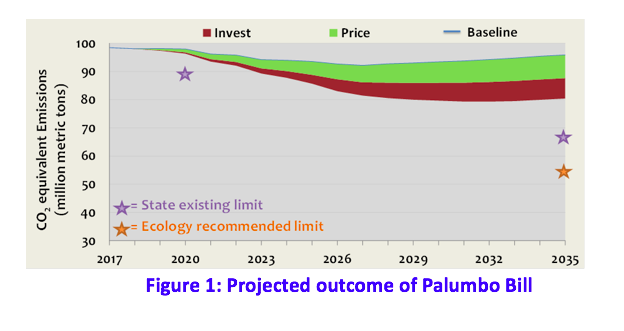A longer form version of this Analysis is available for those interested, at this link. The Longer Form Version Contains All Content in this post, plus an overview of the proposal and a description of key model parameters
Summary
Using a proprietary modeling system, the Washington Business Alliance analyzed the expected outcomes of Senator Palumbo’s Carbon Tax Bill, Senate Bill 5930. SB 5930 is projected to generate a peak of roughly $1.8 billion/year in 2024 (in USD, 2018), and reduce greenhouse gas emissions by a similar amount as the Clean Air Rule (CAR): around 180 million metric tons of carbon dioxide equivalents (MtCO2e) give or take around twenty percent. Emissions in 2035 are projected to be around 9% lower than 1990 levels. The Washington Business Alliance will continue to refine these estimates and provide timely, data-driven reports as bill details emerge, including careful modeling of the Carbon Reduction Fund impacts.
WAShington State Greenhouse Gas Reduction Explorer
The Business Alliance recognizes that effective policy design requires the ability to forecast expected outcomes. The Business Alliance’s driving mission, through Plan Washington, is to Unlock Our State’s PotentialLow Carbon Prosperity Initiative is a primary component of Plan Washington that prioritizes reducing carbon emissions while achieving vigorous economic growth. To that end, the Business Alliance developed the Washington State GHG Reduction Explorer to analyze various policy proposals involving greenhouse gas emissions. This proprietary software is based on the Carbon Tax Assessment Model (CTAM) maintained by the Washington State Energy Office. The model incorporates slight modifications to CTAM, and adds functionality to consider the impact on greenhouse gas emissions and revenue collection of dedicating revenue to invest in carbon reduction projects. Without a reinvestment mechanism, the GHG reduction potential of a tax is limited to the motivational deterrent of higher prices on fossil fuel consumption The model provides the capability to incorporate the Department of Ecology’s Clean Air Rule (CAR), considering overlap between emissions reductions achieved with the simultaneous implementation of CAR and a carbon price. The Departments of Commerce and Ecology evaluated the model and its assumptions, its validity and usefulness to estimate outcomes. The Business Alliance also provided reports on SB 5385 (Hobbs) and HB 1646 (Fitzgibbon).
GHG Reduction Explorer user interface allows policy design considerations to be quickly and cleanly evaluated, both individually and in aggregate. These include: whether or not Ecology’s Clean Air Rule cap is in effect; the starting year for a carbon tax and the initial price charged per metric ton of CO2; the annual rate of tax increase above inflation; the percent of revenue reinvested in carbon reduction projects; and exemptions from the price or cap for certain sectors (petroleum producers and exporters, power producers Energy-Intensive Trade-Exposed (EITE) industries, other non-EITE industries, and local natural gas distribution companies). Beyond the user interface, additional functionality is available to model scenarios with more fine-grained details.
The model provides range of outputs that are tightly and responsively linked to the user inputs described above. These include: Cumulative and annual GHG reductions over time, the impact on the price of commonly purchased units of energy (gallon of gasoline, kWh of electricity, therm of natural gas), the net revenue collected, and the ratio of revenue collected to greenhouse gas emissions reduced beyond the baseline projection.
Beyond these features, the Business Alliance continues to refine and expand Explorer capability. Currently, an economic module for exploring household level, county-by-county impacts is under development to provide an important, decentralized perspective on the upfront cost impacts of any carbon pricing proposals The GHG Reduction Explorer is also readily adaptable to other states, an opportunity the Washington Business Alliance is actively pursuing.
To request a demo of the Explorer, inquire about running customized policy scenarios, or for more information please contact: Colleen McAleer ( President, Colleen@wabusinessalliance.org, (206) 441-5101) or Isaac Kastama (Government Affairs, isaac@wabusinessalliance.org, (253) 232-5313)
Projected Emissions Impact
The model projects SB 5930 will reduce cumulative GHG emissions to ~180 MtCO2e below the baseline from 2018-2035 (Figure 1). The two main drivers of this reduction are from the price signal impact on fuel consumption choices, and the use of revenues to Carbon Reduction Investment Fund programs and tax credit investments by utilities. This reduction is essentially equivalent to the CAR, a Rule that SB 5930 would repeal. There is uncertainty in the emissions impact estimate. A full, rigorous sensitivity analysis is beyond the scope of this summary report; however a range of +/-20% is a reasonable assumption. Certain exemptions and tax credits are difficult to completely capture with the model framework and there is additional downside risk relative to model projections, possibly -20 MtCO2e for the 2018-2035 cumulative projection.
Net new carbon reductions from the price signal response are projected to be around 100 MtCO2e from 2018-2035, approximately 55% of the emissions reductions below baseline. The remaining greenhouse gas emissions reduction are from the Carbon Reduction Investment Fund expenditures plus investment of tax credits by utilities. Achieving the 2035 state limit via SB 5930 would require some combination of not exempting imported electricity, allowing the price to increase with the rate of inflation, increasing the share of revenues to the Carbon Reduction Investment Fund beyond 45%, and further increasing the tax collected per ton of carbon dioxide.
PROJECTED REVENUE IMPACT
The total revenue from SB 5930 through 2035 is projected to be approximately $25 billion in USD, 2018, peaking at nearly $1.8 billion annually in 2024.
The revenue implications, with approximately the same +/- 20% uncertainty as described for the emissions reduction, are projected to be:

On an annual basis and by various expenditure categories, the revenues are projected to be disbursed through 2035 as shown in Figure 2:
Figure 2: Annual expenditures by spending category
For more information please contact:
Colleen McAleer, President Colleen@wabusinessalliance.org (206) 441-5101
or Isaac Kastama, Government Affairs isaac@wabusinessalliance.org (253) 232-5313
